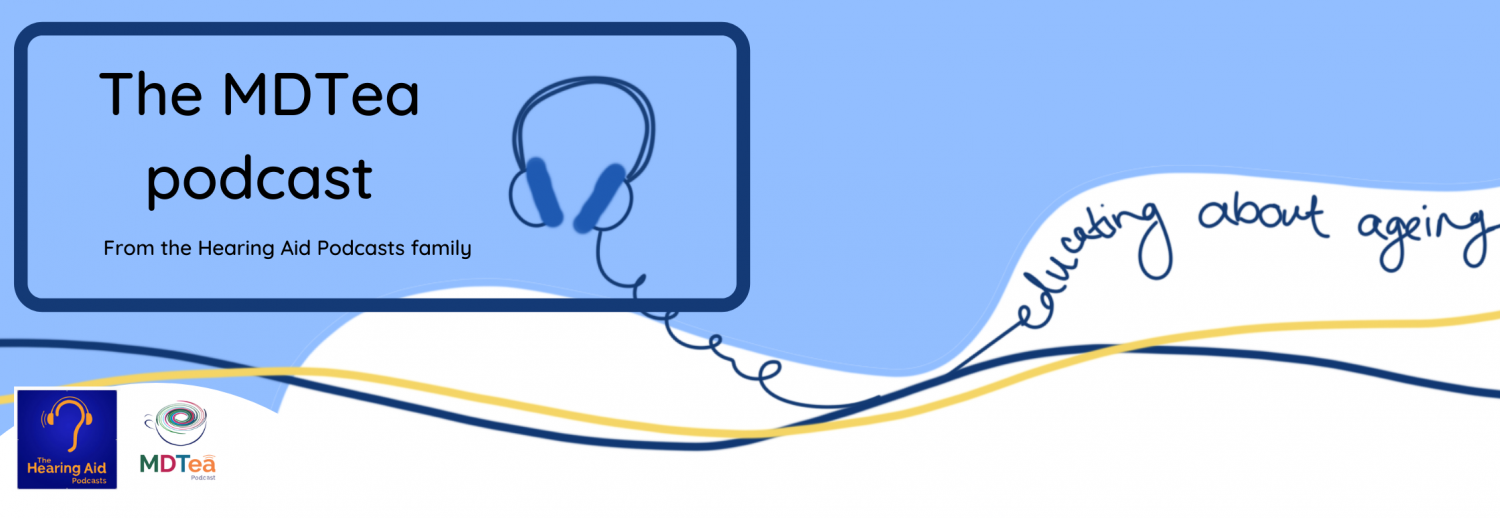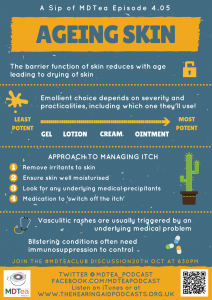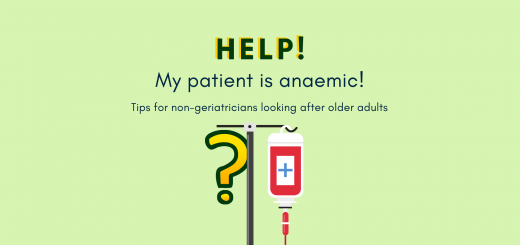4.05 Ageing Skin
Presented by:
Dr Iain Wilkinson (Consultant Geriatrician East Surrey Hospital)
Dr Jo Preston (Consultant Geriatrician St George’s Hospital)
Faculty:
Dr Bernard Ho, Dermatology Clinical Fellow
Sip of MDTea
PDF version of infographic here
Broadcast Date: 10th October 2017
CPD log
Click here to log your CPD online and receive a copy by email.
Tweetchat #MDTeaClub
We will be hosting a ‘journal club’ type tweet chat to discuss topics raised in the episode on 18th October at 8.30pm BST using #MDTeaClub
Join us to discuss topics raised in the episode. We will post a chat summary here after it has taken place in case you miss it.
Social media Spots this week
Exercise for Frail Older Adults https://t.co/6Ywx5OSExW
— Cambridge Geriatrics (@CamGeris) 9 September 2017
Canadian Geriatrics Society book and film list
Show notes
PDF version here
Learning Outcomes
Knowledge:
- To understand normal physiology of the skin and how it changes in older adults
- To develop an understanding of how to manage dry skin in older adults
- To understand causes of itchy skin as a presenting complaint
Skills:
- To be able to recognise different emollients and how emollients they should be used
Attitudes:
- Recognise dermatological issues can be a manifestation of an underlying systemic medical problem
- To consider visual assessment in those falling, with delirium and as part of a CGA
Definitions:
- Xerosis – skin that is dry to touch, due to lack of moisture in the outer layer of the skin (stratum corneum), resulting in cracked skin
- Pruritus – itchy skin or unpleasant sensation that provokes the desire to scratch
Key Points from Discussion
Ageing skin physiology
See also Series 3 episode 3 for discussion of ageing skin physiology
- Protection:
- Accumulation of UV damage as people age
- Cell aging via loss of telomere ends
- Barrier:
- Decreased sebum protection
- Epidermal thinning; flattening of dermo-epidermal junction;
- Pain receptor:
- Dermal thinning → reduction in nerve endings ➔ decreased sensation
- Neuropathic pain increases
- Thermoregulation
- Dermal thinning → reduced function to thermoregulate: hypothermia more common
- Reduced moisture retention
- Reduced ability to vasodilate in the capillary bed ➔ prone to heat retention
- Endocrine function (Vit D, melanin)
- Decreased ability to synthesis vit D ➔ prone to vit D deficiency/reduced bone density
- Decreased ability to synthesis melanin ➔ prone to skin cancers (in addition to photodamage done in previous years)
- Communication/Visual appearance
- Wrinkling/Sagging of skin
- Loss of demarcation between chin and neck in males
Dry skin
- Causes:
- Genetic: Ichthyosis
- Age related changes
- Dry environment, low humidity
- Drugs: retinoids, diuretics, EGFR inhibitors
- Postmenopausal
- Medical causes: hypothyroidism, CKD, malnutrition, dermatitis/eczema
- Complication:
- Eczema, infection (through cracks in skin allowing infection in), contact allergy
- Management
- Emollients, emollients, emollients
- Things to consider:
- Severity of the dryness
- Tolerance
- Personal preference
- Cost and availability
- Avoid aqueous cream as an emollient choice
- Further reading:
Itchy skin
- Causes:
- Systemic:
- Renal: Chronic renal failure – buildup of urea and waste materials
- Liver: Cholestatic – buildup of bilirubin
- Endocrine/metabolic: DM; hyperthyroidism; hypoparathyroidism
- Hematological: IDA; polycythaemia; leukaemia; lymphoma
- Neurological: neuropathic pruritus
- Psychogenic: skin picking; depression; anxiety; delusional parasitosis
- Oncological: can precede underlying malignancy such as lymphoma by many years
- Skin diseases:
- Psoriasis, Urticaria, Allergic contact dermatitis, Dry skin, Dermatitis herpetiformis, Scabies, Mycosis fungoides
- Exposure-related:
- Allergens/irritants – check contacts and exposures
- Insects/infestations (i.e. bed bugs)
- Medication (i.e opioids as side effect)
- Systemic:
- Pruritus screen
- Bloods can look for signs of the systemic diseases above
- Consider:
- Antimitochondrial antibody – autoimmune conditions
- CXR
- Immunoglobulins
- Plasma electrophoresis
- Management: Treat underlying cause; Emollients, emollients, emollients
Elderly Hospitalised Patients – The Impact of Itch and Its Prevalence. Teoh et al, 2016. Annals of Academic Medicine Singapore
Prevalence of skin diseases in hospitalized geriatric patients: Association with gender, duration of hospitalization and geriatric assessment. Makrantonaki et al 2017
Cutaneous Vasculitis
This is a complex collection of conditions with many different causes. Vasculitides are classified by the size of the vessels affected; small, medium or large.
- Older people are most likely to get small vessel vasculitis
- Presents with raised palpable purple areas called purpura, or occasionally ulcers
- Diagnosis
- Biopsy – histology shows inflamed blood vessels
- Reactive vasculitis
- E.g. Secondary to acute infection
- Tends to settle in 6-8 weeks
- Supportive measures- emollients, topical steroids, light compression
- Vasculitis secondary to underlying inflammatory process
- May be more severe and persistent
- Need to manage underlying condition
Further reading:
https://www.dermnetnz.org/topics/cutaneous-vasculitis
Blistering conditions
Autoimmune basis
Usually require immunosuppression with steroids +/- steroid sparing agent
Resources:
Videos of how to apply emollients, and topical steroids.
http://www.bad.org.uk/for-the-public/patient-information-videos
Curriculum Mapping:
This episode covers the following areas (n.b not all areas are covered in detail in this single episode):
| Curriculum | Area | |
| NHS Knowledge Skills Framework | Suitable to support staff at the following levels:
| |
| Foundation curriculum | Section
2 4 10 | Title
Patient centred care Self directed learning Support for patients with long term conditions |
| Core Medical Training | Common competences:
System specific competences:
| |
| GPVTS program | Section 3.05 – Managing older adults
Section 3.21 – Care of people with skin problems
| |
| ANP (Draws from KSF) | Section 6 Clinical Examination
Section 7.31 Problems with Skin Section 20 Patient as central focus of care |






